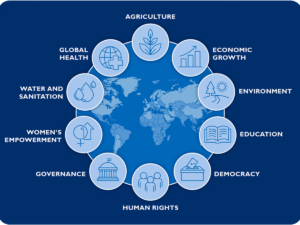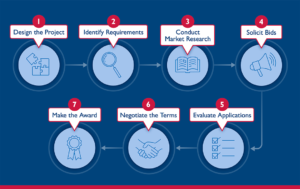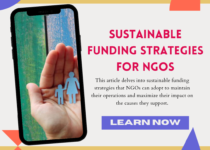USAID Grants Application Guidance: Free Guide for NGOs
Introduction: USAID Grants Application Guidance, to start your journey with this guide let us first understand the charter of USAID and how does it work? United States Agency for International Development (USAID) is known for providing grants, as well as various forms of assistance, to support interventions and development projects in different countries.
These grants and assistance programs are designed to address a wide range of issues, including humanitarian relief, economic development, healthcare, education, environmental conservation, governance, and more.
USAID works with partner organizations, governments, non-governmental organizations (NGOs), and other stakeholders to implement these projects and initiatives. The agency plays a crucial role in promoting stability, economic growth, and improved living conditions in many parts of the world through its grant programs and development efforts.
USAID Grants Application Guidance: Free Guide for NGOs
Here’s a free guide on how NGOs can secure grants from USAID. Keep in mind that the process can be competitive and complex, so it’s important to thoroughly research and understand the specific requirements and guidelines for the grants you’re interested in pursuing.
Understanding USAID mission and priorities
Before you embark on the journey to respond to USAID RFP or Call for proposals you must first clearly understand the USAID as an organization and how professionally they work and deal with individuals and nonprofit organizations that seeks grants from them.
Here is the first step to understand USAID better, go thoroughly to their number of websites and read the content like you preparing for an exam. It will give you a clear idea on the whole system under the USAID works.
Check out here the reference website for USAID Link
That said, we will also provide key information on the process they use to select a proposal submitted as a response to their RFP or call for proposal.
Now let’s dive into the USAID priority area of social development
Although, the agency work in many areas of philanthropy and social issues, our research tells us that their primary focus of work is in these areas.

- Agriculture and Food Security
USAID is enhancing worldwide food security by assisting families and individuals in fulfilling their requirements for a dependable supply of high-quality food and the necessary means to either produce or acquire it. This, in turn, fosters global stability and well-being. By tackling the underlying factors of hunger, USAID is fostering economic opportunities and development within marginalised communities.
- Economic Growth
USAID promotes comprehensive, enduring, and robust economic growth in our partner nations as a fundamental strategy to diminish poverty and reduce dependence. We collaborate with host governments, local and international private sector entities, non-governmental organizations, development assistance groups, financial institutions, and other contributors to nurture development driven by entrepreneurship.
- Environment, Energy and Infrastructure
The substantial advancements in global development are facing growing risks from unparalleled environmental deterioration, the effects of climate change, and insufficient infrastructure to uphold enhancements in human well-being.
The underlying factors and repercussions of environmental and natural resource degradation, climate change, and pollution transcend various sectors, and the escalating gravity and intricacy of these environmental challenges demand a fresh approach at USAID. This approach moves beyond isolated environmental initiatives and emphasises improved integration and cooperation throughout the Agency.
USAID Grants Application Guidance: Free Guide for NGOs
- Education
The Strategy strives to create a world in which educational systems in partner nations empower every individual to attain the education and skills necessary to become valuable contributors to society.
The USAID Center for Education, housed within the Bureau for Development, Democracy, and Innovation (DDI), drives the implementation of the USAID Education Policy. This policy is designed to bring about enduring and quantifiable enhancements in learning achievements and skill development.
- Democracy, Human Rights and Governance
Ever since the introduction of our Democracy, Human Rights, and Governance (DRG) strategy, USAID has maintained a steadfast commitment to infusing democracy-related initiatives into the heart of our fundamental development efforts. Our focus is centered on enhancing and advocating for human rights, ensuring access to justice, fostering accountable and transparent governance, and supporting an autonomous and politically engaged civil society in all our undertakings.
We pursue the four key objectives of our DRG strategy by safeguarding and upholding human rights, guaranteeing the possibility of free and equitable elections, countering disinformation, bolstering digital security for both traditional and modern media, and integrating principles of rule of law and justice into our human rights initiatives.
- Women’s Empowerment
USAID envisions a world characterised by both prosperity and tranquillity. In this world, people of all genders and gender identities, throughout their lifetimes, experience equal rights. They possess the capacity to secure improved lives for themselves, their families, their communities, and their nations. They enjoy unbiased access to top-tier education, healthcare, justice, and economic opportunities. They have the ability to accumulate and manage their own assets and resources, as well as the freedom to express their voices. Importantly, they live without the constraints of rigid gender norms, beliefs, or practices, including threats, harassment, bias, and violence.
In this transformed world, power imbalances have been reshaped to enhance the well-being of individuals in all their diverse identities.
- Water and Sanitation
Water and sanitation play a critical role in advancing worldwide well-being, economic growth, stability, and adaptability. Ensuring dependable access to clean and safe water, sanitation, and hygiene not only preserves lives but also enhances people’s livelihoods and fortifies communities.
Investments in the management of water resources contribute to economic development, bolster agriculture, and protect ecosystems. Despite the challenges posed by global pandemics, heightened conflicts, and the effects of climate change, a greater number of individuals now have access to safe drinking water and effectively managed sanitation services than ever before.
USAID collaborates daily with governments, local stakeholders, and partners to expedite progress towards universal access to water and sanitation, as well as a world that is resilient to water-related challenges.
- Global Health
For more than half a century, USAID’s global health initiatives have been instrumental in preserving lives, safeguarding the most susceptible individuals from diseases, and fostering the stability of communities and nations. These endeavours have also contributed to the enhancement of American security and prosperity. The United States is more secure and robust when people can lead healthy and productive lives, and when nations worldwide can rely on their own resources and resilience.
USAID’s worldwide health endeavours, built upon investments in strengthening healthcare systems and pioneering innovations, revolve around three strategic focal points: reducing child and maternal mortality, managing the HIV/AIDS crisis, and combating infectious diseases. Explore further details about our various healthcare initiatives below.
USAID Grants Application Guidance How to Proceed Further
Prepare your proposal using these key focus social issues, USAID will be more than happy to work with you if your interest of work matches theirs.
If they have released a Request or Call for Proposal read the instruction carefully,
Or
You can also send your own proposal to USIAD which is particularly known as unsolicited proposal.
Send your unsolicited proposal to UnsolicitedProposals@usaid.gov
To create a robust proposal for a solicited opportunity, you can adhere to the steps outlined below. Once you’ve thoroughly reviewed the instructions, follow these steps meticulously to ensure a comprehensive and error-free proposal.
Take heed of these steps
STEP 1: Review the eligibility criteria for your NGO to determine if your organization meets all the necessary selection requirements. Once you’ve confirmed that your organization aligns with the required eligibility criteria, you can proceed to the next step.
STEP 2: Craft a compelling proposal that not only highlights the project’s necessity as outlined in the USAID call but also reinforces your case with up-to-date data and a thorough needs assessment report. These elements will vividly demonstrate why your NGO is a worthy candidate for grant funding.
Make sure to use the below points in your proposal to make it grants worthy
- Executive Summary:
- Introduction:
- Project Description:
- Methodology:
- Budget:
- Expected Outcomes:
- Sustainability Plan:
- Organisational Capacity:
- Partnerships and Collaboration:
- Community Involvement:
- Risks and Mitigation Strategies:
- Monitoring and Evaluation Plan:
- Reporting:
- Attachments and Supporting Documents:
- Appendices:
STEP 3: Thoroughly examine your application and proposal one more time to eliminate any errors or inconsistencies, ensuring the creation of a finalized version of your proposal.
STEP 4: Compile the essential documentation required for your proposal submission, ensuring that you align with the specific documents outlined in the Request for Proposal (RFP). These documents will be submitted alongside your proposal.
STEP 5: Follow the registration process and attend to the finer details as per the instructions specified in the call for proposal. Alternatively, you can utilize the email address provided in the RFP for this purpose.
To successfully navigate the USAID selection journey, it’s crucial to grasp the inner workings of their Grants and Contract Process. This process typically determines the selection of partnering NGOs and holds the key to your participation.
Take this part very seriously,

USAID Grants Application Guidance and USAID general practice
Step 1: Project Design
To gain insight into the obstacles and available resources for tackling them, USAID Missions formulate a comprehensive Country Development Cooperation Strategy (CDCS). This strategy is developed with substantial input from partner governments, as well as industry, civil society, and development partners. Based on the CDCS, we then shape projects and activities to formulate an Acquisition and Assistance (A&A) plan.
Step 2: Activity Requirement
USAID outlines the anticipated outcomes for specific initiatives that could receive funding via an Acquisition and Assistance (A&A) award. Organizations wishing to collaborate with us submit a proposal in response to a solicitation. This proposal details the program’s nature and elucidates the process by which USAID will arrive at its decision.
Step 3: Market Research
USAID engages in market research to explore diverse avenues for achieving our development goals and to collect data regarding local capabilities, the involvement of small businesses, and the viability of our projected needs. One of our methods for accomplishing this is by issuing a Request for Information (RFI).
Step 4: Solicitation
Solicitations delineate the specific need or program and elucidate the criteria by which USAID will assess submissions. These solicitations can manifest in various formats, including a Request for Proposal (RFP), a Notice of Funding Opportunity (NOFO), an Annual Program Statement (APS), or a Broad Agency Announcement (BAA).
Step 5: Evaluation
As a part of the technical proposal review, typical evaluation criteria include the following:
- Past performance (does not have to be USAID past performance).
- Technical approach.
- Personnel.
- Corporate capability.
- Management plans.
Within each solicitation, USAID furnishes the criteria it will utilize to determine award recipients, which encompass both technical and cost/price factors. Additionally, the solicitation outlines the relative significance of each of these factors.
Step 6: Negotiation
If your proposal or application is under consideration for an award, your organization may receive communication from a Contracting or Agreement Officer (CO/AO), who will serve as your primary liaison for conducting business with USAID. Should USAID intend to engage in negotiations with your organization prior to awarding the grant, it is essential for your organization to familiarise itself with our policies, which will be integrated into the contract or assistance award.
Step 7: Award
After the fulfilment of these procedures, USAID will confer the award to the chosen organization. Typically, the organization will be extended an invitation to attend a post-award conference to delve into project details and go over the award’s terms and conditions.
Furthermore, during the implementation phase, the organization can reach out to the Contracting or Agreement Officer’s Representative (COR/AOR), as assigned in the award, for technical guidance. However, any matters related to the award itself should be directed to the Contracting or Agreement Officer.
We have put together the best overview of the Grants selection process of USAID
As an NGO partner you should also take time to read their policies and guidelines thoroughly so that you may comply better.
Disclaimer: The guidance provided for USAID grants applications is derived from our research and may undergo revisions. Therefore, it is advisable to exercise your judgement and discretion when utilizing this information.
In conclusion, this guide has endeavoured to provide valuable insights into the process of securing grants from USAID. Navigating the intricacies of grant applications can be challenging, but with dedication, strategic planning, and a thorough understanding of USAID’s guidelines, your NGO can enhance its prospects of securing vital funding for projects that make a positive impact on communities worldwide.
Remember that the landscape of grant opportunities is dynamic, so staying informed, adaptable, and aligned with USAID’s mission and priorities will be key to your organization’s success. Best of luck in your grant-seeking endeavours, and may your projects drive positive change and progress across the globe.
Hey, STEAL our Best Premium Content For Absolutely Free, Check Out the Links below
HOPE these will add value to your existing skills and knowledge
Our information bears no cost (it’s absolutely FREE), don’t let valuable information slip away.
Join our community of avid readers who are always in the know. Subscribe to our website; stay connected and engaged with the latest news, trends, and developments by subscribing today.
(PUSH the bell ICON)
Leverage the power of knowledge to propel your organization to new heights. Don’t miss out – explore our content
- Latest Funds for NGOs,
- NGO Jobs
- Resources (Helpful Guides and Courses)
- Premium Resources
- NGO related articles
Empowering Humanity through Funds, Resources and Collective Action
Sharing is Appreciated



